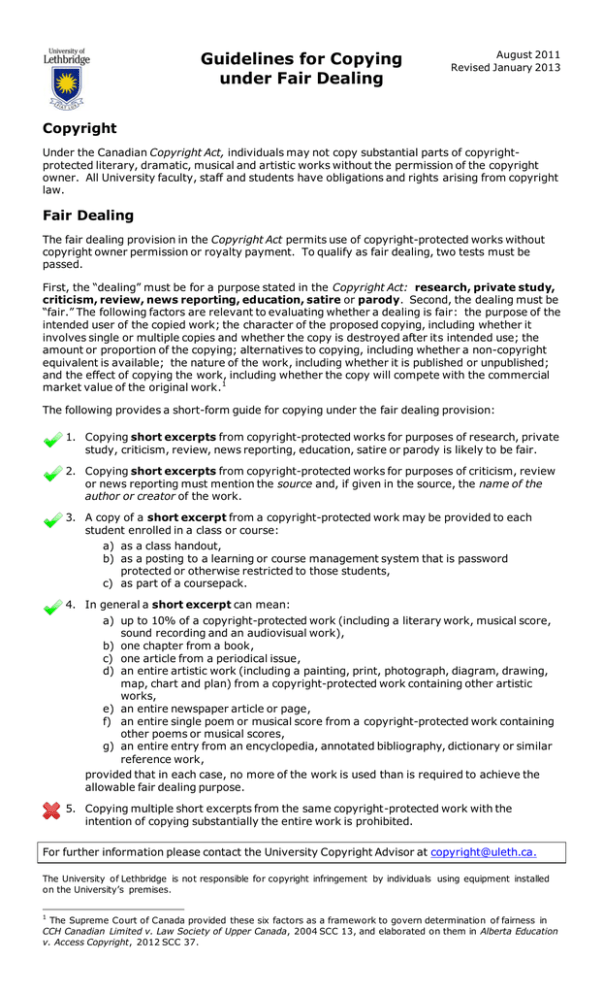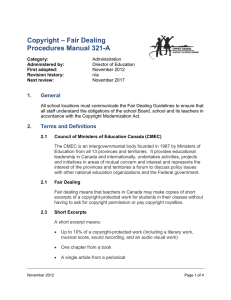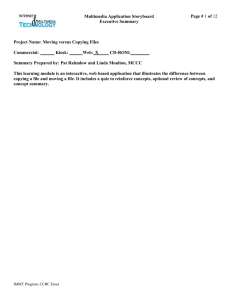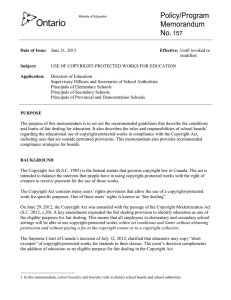Guidelines for Copying under Fair Dealing
advertisement

Guidelines for Copying under Fair Dealing August 2011 Revised January 2013 Copyright Under the Canadian Copyright Act, individuals may not copy substantial parts of copyrightprotected literary, dramatic, musical and artistic works without the permission of the copyright owner. All University faculty, staff and students have obligations and rights arising from copyright law. Fair Dealing The fair dealing provision in the Copyright Act permits use of copyright-protected works without copyright owner permission or royalty payment. To qualify as fair dealing, two tests must be passed. First, the “dealing” must be for a purpose stated in the Copyright Act: research, private study, criticism, review, news reporting, education, satire or parody. Second, the dealing must be “fair.” The following factors are relevant to evaluating whether a dealing is fair: the purpose of the intended user of the copied work; the character of the proposed copying, including whether it involves single or multiple copies and whether the copy is destroyed after its intended use; the amount or proportion of the copying; alternatives to copying, including whether a non-copyright equivalent is available; the nature of the work, including whether it is published or unpublished; and the effect of copying the work, including whether the copy will compete with the commercial market value of the original work.1 The following provides a short-form guide for copying under the fair dealing provision: 1. Copying short excerpts from copyright-protected works for purposes of research, private study, criticism, review, news reporting, education, satire or parody is likely to be fair. 2. Copying short excerpts from copyright-protected works for purposes of criticism, review or news reporting must mention the source and, if given in the source, the name of the author or creator of the work. 3. A copy of a short excerpt from a copyright-protected work may be provided to each student enrolled in a class or course: a) as a class handout, b) as a posting to a learning or course management system that is password protected or otherwise restricted to those students, c) as part of a coursepack. 4. In general a short excerpt can mean: a) up to 10% of a copyright-protected work (including a literary work, musical score, sound recording and an audiovisual work), b) one chapter from a book, c) one article from a periodical issue, d) an entire artistic work (including a painting, print, photograph, diagram, drawing, map, chart and plan) from a copyright-protected work containing other artistic works, e) an entire newspaper article or page, f) an entire single poem or musical score from a copyright-protected work containing other poems or musical scores, g) an entire entry from an encyclopedia, annotated bibliography, dictionary or similar reference work, provided that in each case, no more of the work is used than is required to achieve the allowable fair dealing purpose. 5. Copying multiple short excerpts from the same copyright-protected work with the intention of copying substantially the entire work is prohibited. For further information please contact the University Copyright Advisor at copyright@uleth.ca. The University of Lethbridge is not responsible for copyright infringement by individuals using equipment installed on the University’s premises. 1 The Supreme Court of Canada provided these six factors as a framework to govern determination of fairness in CCH Canadian Limited v. Law Society of Upper Canada, 2004 SCC 13, and elaborated on them in Alberta Education v. Access Copyright, 2012 SCC 37.



